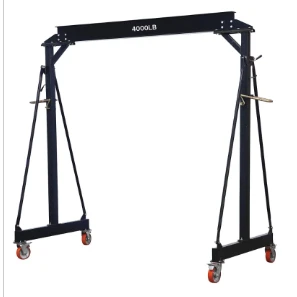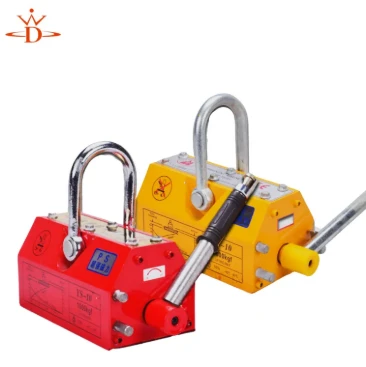Lightweight Gantry Crane for Efficient Lifting Durable Lightweight Overhead Crane System
- Introduction to Lightweight Gantry Crane Technology
- Market Data and Performance Impact
- Technical Advantages of Lightweight Gantry Systems
- Manufacturer Comparison and Industrial Benchmarks
- Customization Options for Advanced Projects
- Application Case Studies across Industries
- Conclusion: The Future of Lightweight Gantry Crane Solutions

(lightweight gantry crane)
Introduction to Lightweight Gantry Crane Technology
Lightweight gantry cranes have revolutionized the world of industrial lifting and materials handling. In a landscape demanding efficiency, adaptability, and precision, these systems have emerged as a fundamental solution. Designed to offer optimal flexibility and structural efficiency, lightweight gantry crane
s are engineered from advanced alloys and composites, ensuring ease of installation and minimal floor loading. Rapid developments in manufacturing and logistics, alongside stringent safety standards, are driving global demand for lightweight overhead crane systems. Companies require solutions that can deliver high performance without the constraints and costs of traditional heavy-duty cranes. This overview sets the stage to explore the unprecedented advantages provided by lightweight gantry technology.
Market Data and Performance Impact
The global lightweight gantry crane market has grown at a steady CAGR of 6.7% over the past five years, exceeding $2.4 billion in annual sales volume by 2023. Industries like warehousing, automotive, and aerospace are contributing to the surge, with manufacturers investing robustly in lightweight overhead crane systems to improve workflow and safety. According to a recent report from MarketsandMarkets, over 68% of surveyed facilities cited a 30% reduction in installation times and a 20% improvement in operational efficiency after implementing a modern lightweight gantry. Energy consumption has also dropped by an average of 18%, thanks to streamlined drive systems and lighter frame materials. These advantages translate directly into competitive operational cost benefits and increased ROI.
- Key Market Insights:
- Global revenue in 2023: $2.4B
- Average operational efficiency gain: 20%
- Energy consumption reduction: 18%
- Major sectors: Warehousing, Automotive, Aerospace, Food & Beverage
Technical Advantages of Lightweight Gantry Systems
Advanced lightweight gantry cranes incorporate precision-engineered structural profiles, such as aluminum and high-strength steel, facilitating enhanced portability without sacrificing durability. Their modular designs allow for quick assembly and disassembly, making them ideal for evolving production environments. Many systems are equipped with height-adjustable features and span configurations tailored to site-specific requirements. Integrated safety components, such as anti-collision sensors and overload protectors, have become standard, reducing workplace incidents by up to 35% as per OSHA data.
- Technical Highlights:
- Load capacities from 0.5 to 10 tons
- Span options: up to 12 meters
- Height adjustability: 2 to 5 meters
- System mobility: manual or motorized
- Installation time: under 2 hours (average)
These technical advancements ensure lightweight gantry systems are not only future-ready but also compatible with Industry 4.0 standards for operational analytics and smart maintenance.
Manufacturer Comparison and Industrial Benchmarks
Selecting the right lightweight gantry crane manufacturer is paramount. Differences in material engineering, after-sales support, and integration technology can impact facility performance. Below is a data-driven comparison of leading suppliers in the lightweight overhead crane system market:
| Manufacturer | Material | Max Capacity (tons) | Footprint (sqm) | Adjustability | Warranty (years) | Average Price ($) | Customer Rating |
|---|---|---|---|---|---|---|---|
| Konecranes | Aluminum Alloy | 3 | 14 | 2 Heights / 3 Spans | 2 | 8,900 | 4.7/5 |
| Gorbel | Steel & Aluminum | 2 | 12 | Variable Height | 3 | 7,400 | 4.6/5 |
| Demag | High-Tensile Steel | 5 | 16 | Dual Mode | 1.5 | 10,300 | 4.8/5 |
| Spanco | Light Steel | 1.5 | 10 | Fixed & Mobile | 2 | 6,100 | 4.5/5 |
This comparison highlights the range of customizable solutions, price points, and performance metrics that organizations must evaluate to maximize their investment in lightweight gantry cranes.
Customization Options for Advanced Projects
Every production floor demands unique handling solutions. Modern lightweight gantry crane systems offer tailored configurations to accommodate specific height, span, and environmental constraints. Optional accessories—such as motorized trolleys, wireless remote controls, and corrosion-resistant coatings—enhance both operational reach and system longevity. For cleanroom or hazardous environments, stainless steel adaptations and dust-sealed components ensure compliance with the most rigorous standards.
- Available Customization Features:
- Variable span beams (6m – 12m)
- Height adjustment mechanisms
- Motorized versus manual mobility
- Explosion-proof enclosures
- Integrated IoT monitoring
- Special coatings: weather-proof, corrosion-resistant
Such flexibility ensures that lightweight gantries are not just standardized products but strategic enablers of complex industrial processes.
Application Case Studies across Industries
Lightweight gantry solutions have transformed processes in a multitude of industries. Below are real-world examples exemplifying versatility, ROI, and operational improvements:
- Automotive Manufacturing – Assembly Line Optimization
A Midwest auto manufacturer integrated five lightweight gantry systems, reporting a 35% reduction in changeover time and 22% less workplace injury. Quick relocation of the gantries enabled agile product line updates. - Pharmaceutical – Cleanroom Compliance
In a leading pharma facility, stainless steel lightweight overhead crane systems ensured ISO 6 cleanroom standards, with zero contamination incidents over 18 months and 28% project time savings. - Logistics & Warehousing – Space Utilization
A major e-commerce company installed mobile lightweight gantries, boosting storage density by 19% and achieving an annual cost saving of $120,000 through optimized space use and reduced manual handling. - Food Processing – Safety Enhancement
Introducing a lightweight gantry in a food-grade environment led to a 40% drop in handling errors and a 17% lift in process throughput.
These applications underline how adaptable and performance-led lightweight gantries can transform key operational metrics across sectors.
Conclusion: The Future of Lightweight Gantry Crane Solutions
As global industries pursue efficiency, agility, and safety, lightweight gantry crane technologies are set to remain central to material handling strategies. The advancements in modularity, digital integration, and material science are rapidly expanding the capabilities of lightweight gantry systems. Selecting the right partner and customizing solutions to fit facility-specific needs is crucial for lasting success. With proven data showing gains in both operational performance and cost savings, the lightweight gantry crane stands poised as a decisive asset for manufacturers and logistics operations in the years ahead.

(lightweight gantry crane)
FAQS on lightweight gantry crane
Q: What is a lightweight gantry crane?
A: A lightweight gantry crane is a portable lifting device designed for easy movement and assembly. It is ideal for handling light to moderate loads in workshops or warehouses. This crane offers flexibility and efficiency for various material handling tasks.
Q: What are the benefits of using a lightweight overhead crane system?
A: A lightweight overhead crane system provides efficient material handling with minimal structure weight. It reduces installation costs and is suitable for small or restricted spaces. The system also enhances workplace safety and productivity.
Q: In what applications can a lightweight gantry be used?
A: Lightweight gantries are commonly used in maintenance, assembly lines, and warehouses. They are perfect for temporary or flexible work zones. Their portability allows quick relocation and adaptation to different tasks.
Q: How much weight can a lightweight gantry crane typically lift?
A: Most lightweight gantry cranes can lift loads ranging from a few hundred kilograms up to 5 tons. The exact capacity depends on the specific model and design. Always consult the manufacturer’s specifications for precise limits.
Q: Is it easy to install and move a lightweight gantry crane?
A: Yes, lightweight gantry cranes are designed for easy assembly and mobility. Most models feature wheels and modular components for quick setup and repositioning. This makes them highly convenient for changing job requirements.
-
Dawei Hand Pallet Truck 1200mm, 2000–5000 KGS Heavy-DutyNewsNov.17,2025
-
Dawei Hand Pallet Truck, Fork Length 1200mm, 2000–5000kgNewsNov.17,2025
-
Large Equipment Movers – Safe, Insured & On-Time ServiceNewsNov.17,2025
-
Machine Moving Dollies | Heavy-Duty, Low-Profile, SafeNewsNov.17,2025
-
Permanent Lifting Magnet - Heavy-Duty, Safe, Quick ReleaseNewsNov.11,2025
-
PML 1000 Lifting Magnet - Heavy-Duty, Safe, No PowerNewsNov.11,2025
-
Large Equipment Movers: Safe, Fast, Certified ProsNewsNov.11,2025
